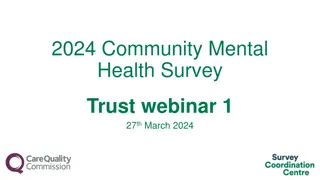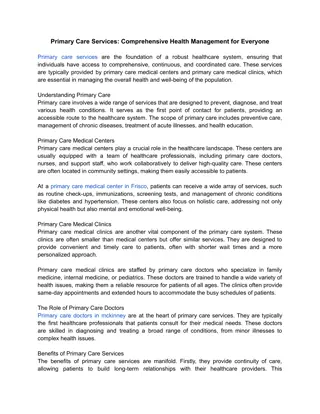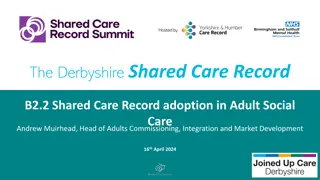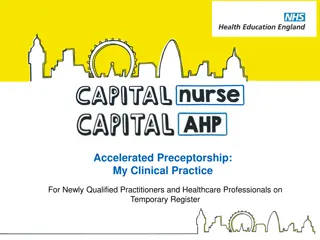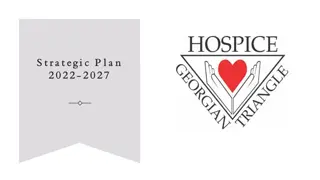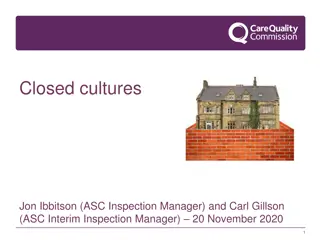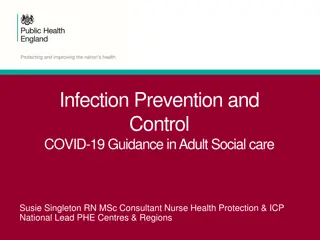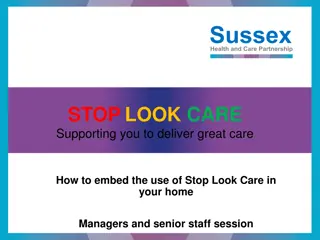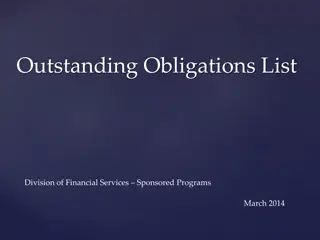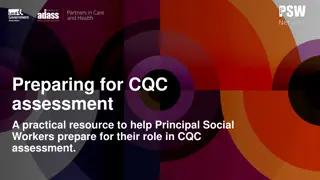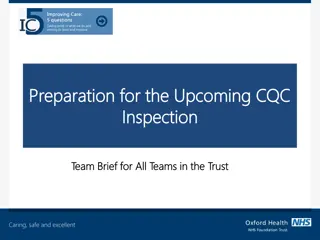Achieving and Maintaining CQC Good and Outstanding: A Guide to Excellence in Care Services
Achieving a rating of good and outstanding from the CQC signifies high-quality care services that benefit both staff and service users. By focusing on good practices, preparing for inspections, and maintaining excellence through innovative ideas and continuous improvement, care providers can ensure a supportive and nurturing environment for all stakeholders involved.
Download Presentation

Please find below an Image/Link to download the presentation.
The content on the website is provided AS IS for your information and personal use only. It may not be sold, licensed, or shared on other websites without obtaining consent from the author.If you encounter any issues during the download, it is possible that the publisher has removed the file from their server.
You are allowed to download the files provided on this website for personal or commercial use, subject to the condition that they are used lawfully. All files are the property of their respective owners.
The content on the website is provided AS IS for your information and personal use only. It may not be sold, licensed, or shared on other websites without obtaining consent from the author.
E N D
Presentation Transcript
Achieving CQC good & outstanding & building and maintaining Quality What does good and outstanding look like and what does it mean for your staff team, service users and their families ? Families felt very reassured knowing that their loved ones is being cared for in a service that goes above and beyond the standards expected. Staff- felt their hard work has been identified extremely proud of their achievements and the ratings have made teams even stronger than they were before; success breed success. Preparing for an inspection Review CQC inspection reports from other services to identify good and poor practice. Consider how this insight can help your service to deliver better care. Engage with other services to see what they re doing to deliver high standards of care (e.g. by arranging visits or via registered manager networks etc.). Plan for mock inspections or robust quality assurance, focusing on all areas that may be looked at as part of the CQC inspection. Consider compiling good practice examples, positive feedback and other success stories into a file or resource to share with the CQC inspector. Evidencing Good Practices Don t sell yourself short - A lot organisation may be ineffective in communicating how it s working and supporting people who need care and support, their families, advocates and others. So these people may have no knowledge of what the service is achieving and unable to evidence some of the positive work the managers and leaders may have conveyed to the CQC inspector. Record best practices- Recording best practice through feedback forms, compliment slips and in newsletters, it can be easy to forget the reasons why we are gathering this evidence. Hundreds of photos of activities, holidays, friendships and special achievements come to life with every page that you turn. Nothing shows best practice more than seeing first-hand the achievements of your residents
Maintaining Outstanding What would the inspector be looking at the next visit: Continued improvements-we knew the inspector would be looking for continued improvements in our service and better outcomes for the people we support. We ensured that we were constantly learning and striving to improve. We had a continued improvement plan in place- example we created Impact cards which highlighted historical information, presenting issues on entry to the service, inputs from the service and then finally the outcomes or impact on the service users quality of life. Highlight the processes you went through to achieve a goal ( for example, a SWOT analysis was explored in order to build an understanding of the type of support required for a resident to achieve a goal of travelling by plane for the first time,. To overcome the threats, which was a fear of heights, staff begun by visiting Theme Parks, London eye and then regular visits to the airport to allow the client to familiarise himself with the check-in process, going through security etc.) Examples innovative ideas that had a positive impact of the lives of the service users LCP Got Talent Show-highlighted talents such as reading, dancing, singing. Colour coded activity planners that covered that activities of daily living such as fun, wellbeing, sensory, helping & family visit. LCP Bake Off- Where clients/services showcased some of their baking talent s The Spectrum Art Exhibition- the aim of this project was to promote the visibility of disability by exhibiting some of the arts and crafts work- selling them and raising money for charity. Creating job opportunities- where possible adapt the environment to create job opportunities such as gardening or allotment , picking up litter around the neighbourhood , Internal mail delivery system, visiting your local rugby or football club. Remember job has to be motivational , rewarding & safe.
Sample Activity Planner This categorised activities according to whether they were social, therapeutic, domestic chores or vocational. These colour-coded categories enabled staff and manager to clearly see in what way someone spent their time in an average week. They were therefore able to review the care and support provided to the person by checking whether they were receiving sufficient opportunities within any particular category. Monday Tuesday Wednesday Thursday Friday Saturday Sunday Time and support level Time and support level Time and support level Time and support level Time and support level Time and support level Time and support level 7.30-9.00 1:1 Personal care and medication 7.30-9.00 1:1 Personal care and medication 7.30-9.00 1:1 Personal care and medication 7.30-9.00 1:1 Personal care and medication 7.30-8.00 1:1 Personal care and medication 7.30-9.00 1:1 Personal care and medication 7.30-9.00 1:1 Personal care and medication Help with laundry Help with laundry Help with laundry Help with laundry Help with laundry Help with laundry Help with laundry 9.00-9.30 1:1 9.00-9.30 1:1 9.00-9.30 1:1 9.00-9.30 1:1 8.00-8.30 1:1 9.00-9.30 1:1 9.00-9.30 1:1 9.30-11.30 1:1 9.30-12.00 1:1 9.30-11.30 1:1 9.30-11.30 1:1 8.30-9.30 1:1 9.30-11.30 1:1 9.30-11.30 1:1 Walk out Walk out Walk out Walk out Hydrotherapy Walk out Walk out Snack time (Bring snacks for activity) Thames Valley Adventure Playground Snack time (Bring snacks for activity) Snack time (Bring snacks for activity) 11.30 1:1 11.30-13.30 1:1 11.30-12.30 1:1 Companion cycling 9.30-14.00 1:1 Reflections 11.30 11.00 Train ride to various places with CDR and RJ e.g., London 11.30-15.00 1:1 12.00-15.00 1:1 12.30 1:1 12.30-13.30 1:1 14.00-15.00 1:1 11.00/15.00 Family visit Gravity Force Lunch out Boat ride Indoor activities 12.30-14.00 Indoor activities Snack time (Bring snacks for activity) Swimming at Teddington or open air pool (If no family visit) Drive out to Bushy Park or Richmond Park for a walk 15.00 1:1 14.30-17.00 1:1 Coral Reef Waterworld 13.30-17.00 1:1 Walk out/Indoor activities 15.00-18.00 1:1 Walk out 15.00-16.00 15.00-17.30 1:1 Walk out to Bushy Park 11.00-17.00 Snack time (Bring snacks for activity) Snack time (Bring snacks for activity) Snack time (Bring snacks for activity) Snack time (Bring snacks for activity) 15.00 15.00 15.00 15.00 15.00-18.00 1:1 Walk out 17.30-19.30 1:1 17.00-18.00 1:1 17.00-18.00 Movie night or DVDs in bedroom 18.00-19.30 1:1 Indoor activities Walk out Takeaway 16.00-19.00 Indoor activities 17.00-19.00 Indoor activities 19.30-21.00 1:1 18.00-21.00 1:1 18.00-21.00 1:1 18.00-21.00 1:1 Walk out/Indoor activities 19.30-21.00 1:1 Walk out Indoor activities Indoor activities Indoor activities 19.00-21.00 Walk out 19.00-20.00 Walk out 21.00-22.00 1:1 21.00-22.00 1:1 21.00-22.00 1:1 21.00-22.00 1:1 21.00-22.00 1:1 Personal care Personal care Personal care Personal care Personal care 21.00-22.00 Personal care 21.00-22.00 Personal care Total: 14.5h Total: 14.5h Indoor/inhouse activities list Total: 14.5h Total: 14.5h Total: 14.5h Total: 14.5h Category Total: Description Key Garden time Fun Fun Swings Domestic chores, DIY, gardening Helping Skills teaching/session plan, college, work placements, job Physical and mental health, personal appearance Education Employment Trampoline Playful interaction with staff (e.g., being tickled, chasing him, etc.) Wellbeing Family visit, home visit social occasions with family Playing with stringy objects Family Sensory Sensory focus
Recruitment Safe Recruitment Check enthusiasm, core skills and appropriateness for the role: Have a robust approach to vetting new members of staff, reducing the risk of an unsuitable person being employed (e.g. follow up personal and professional references, look into their training records, focus on gaps in employment history, check how they would respond to certain scenarios). Involve people who need care and support in the recruitment process-recruitment: involve people using the service and / or their family / advocates in the recruitment process (for example; contribution to the job description, choosing interview questions, being part of the interview panel, being consulted before new workers are selected etc). Follow up DBS checks and references before people start: Obtain Disclosure and Barring Service (DBS) and other identity checks (including rights to work in the UK) prior to the new staff member start date. Ensure a minimum of two references are followed up and all checks are thorough and well document Use probationary periods-Use probation periods of at least three months so the service can assure themselves that new staff are right for the organisation and their role. Effective Retention Ensure managers and leaders work to successfully motivate staff and demonstrate their contributions are valued. Recognise the benefits of low staff turnover to the continuity of care. Recognise the importance of staff wellbeing and the wellbeing of people who use the service. Initiatives to support staff are available; these are well known and recognised by staff and documented, e.g. flexible working patterns, wellbeing initiatives such as discounts with local gyms and stress management training
Leadership Over 90% of services rated good or outstanding for being well-led by the Care Quality Commission (CQC) were also rated good or outstanding overall. If you're working in a leadership or management role you're not only responsible for supporting those who need care and support, but for taking care of staff and influencing the quality of care across the sector. Become a member & join local networks across the country led by registered managers- Examples: Skills for Care: As the membership body for registered managers in England we support you to develop best practice and knowledge, keep up-to-date and share ideas with like- minded managershttps://www.skillsforcare.org.uk/Leadership-management/support- for-registered-managers/support-for-registered-managers.aspx. Autism Accreditation: Autism Accreditation is UK s only autism specific quality assurance programme of support and development for all those providing services to autistic people. Achieving accreditation proves that an organisation is committed to understanding autism and setting the standard for autism practice. https://www.autism.org.uk/professionals/accreditation/about.aspx Investors in people: they help organisation develop stronger leaders at every level of the organisation. Ensure that all people-managers are equipped to provide the best support to their team. https://www.investorsinpeople.com/solutions-accreditation/ i. ii. iii.




